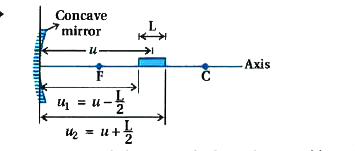The near vision of an average person is 25 cm To view an object with an angular magnification of 10, what should be the power of the microspcope ?Solution in Gujrati
⇒ For healthy human eye, near point is D = 25 cm
∴v=D=25cm
⇒ Here magnification m= 10
and object distance u = f
Now,
m=vu=Df
∴f=Dm=2510=2.5cm
∴=1f=12.5×10−2=40D (dioptre)
Topper's Solved these Questions
- RAY OPTICS AND OPTICAL INSTRUMENTSBOOK - KUMAR PRAKASHANCHAPTER - RAY OPTICS AND OPTICAL INSTRUMENTSEXERCISE - SECTION-C (NCERT EXEMPLAR SOLUTION) (SHORT ANSWER TYPE QUESITONS)
6 Videos
- RAY OPTICS AND OPTICAL INSTRUMENTSBOOK - KUMAR PRAKASHANCHAPTER - RAY OPTICS AND OPTICAL INSTRUMENTSEXERCISE - SECTION-C (NCERT EXEMPLAR SOLUTION) (LONG ANSWER TYPE QUESITONS)
5 Videos
- RAY OPTICS AND OPTICAL INSTRUMENTSBOOK - KUMAR PRAKASHANCHAPTER - RAY OPTICS AND OPTICAL INSTRUMENTSEXERCISE - SECTION-C (NCERT EXEMPLAR SOLUTION) (MULTIPLE CHOICE QUESTIONS (MCQs))
16 Videos
- MOVING CHARGES AND MAGNETISMBOOK - KUMAR PRAKASHANCHAPTER - MOVING CHARGES AND MAGNETISMEXERCISE - SECTION D (MCQs ASKED IN COMPETITIVE EXAMS)
34 Videos
- SAMPLE QUESTION PAPER BOOK - KUMAR PRAKASHANCHAPTER - SAMPLE QUESTION PAPER EXERCISE - PART-B SECTION-C
5 Videos
Similar Questions
A short object of length L is placed along the principal axis of a concave mirror away from focus. The object distance is u. If the mirror has a focal length f, what will be the length of the image ? You may take L<<|v−f|.

View SolutionShow that for a material with refractive index μ≥√2~ , light incident at any angle shall be guided along a length perpendicular to the incident face.
View SolutionA ray of light incident at an angle θ on a refracting face of a prism emerges from the other face normally. If the angle of the prism is 5∘ and the prism is made of a material of refractive index 1.5, the angle of incidence is
View SolutionElectric charge Q having mass M moves on a circular path of radius R with velocity →v, perpendicular to uniform magnetic field B. When a particle completes one revolution, work done by the field is _______
View SolutionTwo charges –q and +q are located at points (0, 0, –a) and (0, 0, a), respectively.
(a) What is the electrostatic potential at the points (0, 0, z) and (x, y, 0) ?
(b) Obtain the dependence of potential on the distance r of a point from the origin when r/a>>1 .
(c) How much work is done in moving a small test charge from the point (5,0,0) to (–7,0,0) along the x-axis? Does the answer change if the path of the test charge between the same points is not along the x-axis?
View SolutionAn object is to be seen through a simple microscope of focal length 12 cm. Where should the object be placed so as to produce maximum angular magnification? The least distance for clear vision is 25 cm.
View SolutionThe near vision of an average person is 25cm. To view an object with an angular magnification of 10, what should be the power of the microscope ?
View SolutionAn object is to be seen through a simple microscope of power 10 D . Where should an object be placed to produce maximum angular magnification ? Least distance of distinct vision is 25 cm .
View SolutionAn object is to be seen through a simple microscope of power 10D. Where should the object be placed so as to produced maximum angular magnification ? The least distance for distinct vision is 25 cm.
View SolutionFor a person near point of vision is 100cm. Then the power of lens he must wear so as to have normal vision, should be
View Solutionदीर्घदृष्टि वाला एक व्यक्ति जो अपनी आँखों से 75 cm से निकट की वस्तुओं को साफ -साफ नहीं देख सकता , 25 cm दूर रखी पुस्तक को पढ़ना चाहता है । सुधार करनेवाले लेंस की प्रकृति और शक्ति क्या होनी चाहिए ?
View SolutionA person using spectacles having power +2.5m^(-1) can see the objects distinctly at a distance of 25 cm . What is the near point for the person ? What type of defect of vision does the eye have ?
View SolutionFor a person near point of vision is 100 cm. Then the power of lens he must wear so as have normal vision, should be
View SolutionA simple microscope of power 15 D is used to see an object. If the least distance of distinct vision is 25 cm, where should the object be placed so as to produce maximum angular magnification?
View SolutionThe near vision of an average person is 25cm. To view an object with an angular magnification of 10, what should be the power of the microscope ?
View Solution
